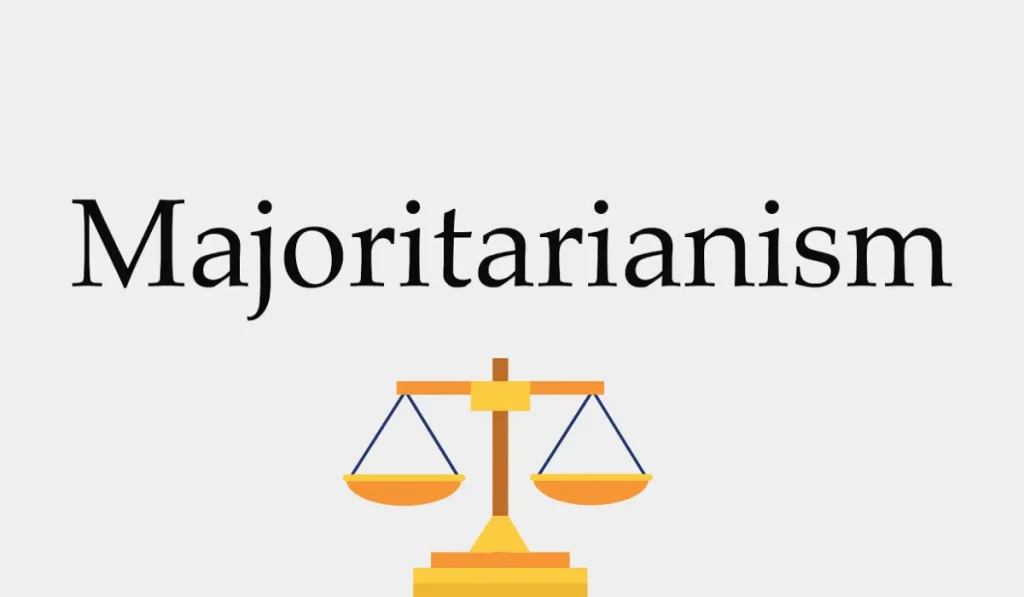Contents
- 1 What is Majoritarianism how has it increased the feeling?
- 2 History of Majoritarianism:
- 3 What are the Five Major Features of Majoritarianism?
- 4 What are the types of majoritarianism?
- 5 What are some examples of Majoritarianism?
- 6 What are the pros and cons of Majoritarianism?
- 7 What is the difference between Majoritarianism and Democracy?
- 8 FAQs related to Majoritarianism:
- 9 Conclusion
Majoritarianism is derived from the Latin word “major” meaning “greater” and “arista” which means “branch, point.” It is a political theory which supports democracy and the right of the majority to rule. This blog outlines the history and nature of majoritarianism.

The theory of majoritarianism is the belief that democracy is the best form of government, and that the majority of the people in a society should have the power to make decisions for the society.
What is Majoritarianism how has it increased the feeling?
Majoritarianism is a political system where the state is ruled by the majority. This means that the state is ruled by the decision of the most people. The feelings that are raised by majoritarianism are feelings of power, security, and safety. Majoritarianism has increased the feeling of power and safety in people’s lives by giving them control over the state and the people in it.
Majoritarianism has increased the feeling of security by increasing the feeling of safety within the state. Majoritarianism has also increased the feeling of security by making the state a place where rights and freedoms are upheld. Majoritarianism has increased the feeling of safety because it has made the state a place where the people are safe from the outside world.
History of Majoritarianism:
Majoritarianism was created to balance the power in a democracy by giving the majority of people more power and influence in the decision-making process. Majoritarianism has its roots in Ancient Greece, but it wasn’t until the advent of democracy in 18th-century Britain that the term came into widespread use. It was used to describe the first form of democracy, which was majoritarian democracy, also known as pure democracy, in which every adult male citizen was allowed to vote.
In the 19th century, the concept was taken and applied to countries with a republican system of government to describe the concept of a legislature composed of the most powerful members of society. The twentieth century saw the rise of the term majoritarianism as it was applied to democracy in general.
What are the Five Major Features of Majoritarianism?
Majoritarianism is a form of government in which the majority of citizens have the power to make decisions for the whole society. The five major features of Majoritarianism are:
- Majoritarianism is the principle which calls for a government in which the majority rule.
- Majoritarianism is the idea that the majority should rule over the minority.
- Majoritarianism is a system of government where the rights of the majority of the population are respected, but the rights of the minority are not.
- The majority of the population do not have the same rights or power as the minority and the minority are not automatically threatened by the majority.
- Majoritarianism is the principle which calls for a government in which the majority rule.
What are the types of majoritarianism?
There are three types of majoritarianism: direct, consensus and indirect.
Direct majoritarianism is when the people of a state have an election for the government and the people win the election.
Consensus majoritarianism is when the people of a state elect their government, but the people don’t have a say in how the government is run.
Indirect majoritarianism is when there is no election for the government but the government is elected by other means.

What are some examples of Majoritarianism?
When it comes to majoritarianism, there are many types of governments that can be classified as a majoritarian government. Examples of majoritarianism include: United States, Canada, France, the United Kingdom, India and Thailand.
What are the pros and cons of Majoritarianism?
The Pros of majoritarianism are that:
- It can lead to greater efficiency and effectiveness.
- It can lower the tax rates because a majority government can push through the tax cuts with ease.
- Some people like majoritarianism because they believe that the majority will make the best decisions because they can see from the perspective of most.
The Cons of Majoritarianism are that:
- It can be undemocratic, and it is not able to represent the new, changing views of the population
- People feel like they can have a say in their government.
- It may not be fair to smaller groups of people.
What is the difference between Majoritarianism and Democracy?
In a Majoritarian system, the state is ruled by the majority. Majoritarianism is a term used to describe a system of government in which the state is ruled by the majority. In this system, the state is ruled by an elected body of people. If the majority of people agree on something, they can vote to pass the legislation. If the majority of people disagree on something, they cannot vote to pass the legislation.
In a Democracy, the state is ruled by the will of the people. This means that the state is ruled by the majority vote of the people. In a Democracy, the state is ruled by the will of the people. If the majority of people agree on something, they can vote to pass the legislation. If the majority of people disagree on something, they cannot vote.
Which country adopted majoritarianism model?
Sri Lanka adopted the majoritarianism model
What are the key concepts of a Majoritarian government?
The key concepts of a Majoritarian government are: 1) a constitution, 2) a President, 3) a bicameral legislature, 4) a judiciary, and 5) a prime minister.
What are the major criticisms of Majoritarianism?
Majoritarianism is often criticized for stifling minorities and not being able to preserve the minority’s rights.
Conclusion
Majoritarianism is a political system in which the country’s largest and most influential political party or majority wins the most elections and typically forms the government. The term was originally used to describe the dominant political system in England during the 18th century, but it is now applied to different forms of government, including a pure democracy, a direct democracy, a republican democracy, and an oligarchy.
We hope you found the information in our post “what is Majoritarianism” to be helpful on this interesting topic. Just as it sounds, “Majoritarianism” is a political system associated with the idea that the majority should govern the country. It’s based on the principle that the population should rule a country.
Thank you for reading and we hope that you learn more about the topic by visiting www.edukar.in



![A House Is Not A Home Question Answer [Class 9 English Moments Chapter 8] A House Is Not A Home Question Answer](https://edukar.in/wp-content/uploads/2023/01/A-House-Is-Not-A-Home-Question-Answer-1024x640.webp)
![Packing Class 9 Questions and Answers [Class 9 English Beehive Chapter 7 ] Packing Class 9 Questions and Answers [Class 9 English Beehive Chapter 7 ]](https://edukar.in/wp-content/uploads/2023/01/Packing-Class-9-Questions-and-Answers-1024x640.webp)


![Natural Vegetation and Wildlife Class 9 Questions Answers [Class 9 Geography Chapter 5] Natural Vegetation and Wildlife Questions Answers](https://edukar.in/wp-content/uploads/2023/01/Natural-Vegetation-and-Wildlife-Questions-Answers--1024x640.webp)
![My Impression Of Assam Question Answer [Class 11 English Chapter 9] My Impression Of Assam Question Answer](https://edukar.in/wp-content/uploads/2022/12/My-Impression-Of-Assam-Question-Answer-1024x640.webp)
![Asleep in the Valley Questions and Answers 2023 [Class 12-English] Asleep in the Valley Questions and Answers](https://edukar.in/wp-content/uploads/2022/12/Asleep-in-the-Valley-Questions-and-Answers-1024x640.webp)
![Footprints Without Feet Question Answer [Class 10 Chapter 5 NCERT Solutions] Footprints Without Feet Question Answer](https://edukar.in/wp-content/uploads/2022/12/Footprints-Without-Feet-Question-Answer-1024x640.webp)

![The Poetry of Earth Question Answer 2023 [Short & Long] The Poetry of Earth Question Answer](https://edukar.in/wp-content/uploads/2023/01/The-Poetry-of-Earth-Question-Answer-1024x640.webp)

![No Men Are Foreign Class 9 Question Answer [NCERT] No Men Are Foreign Class 9 Question Answer](https://edukar.in/wp-content/uploads/2023/01/No-Men-Are-Foreign-Class-9-Question-Answer-1024x640.webp)
![How To Tell Wild Animals Questions and Qnswers [English Class 10 Chapter 4] How To Tell Wild Animals Questions and Qnswers [English Class 10 Chapter 4]](https://edukar.in/wp-content/uploads/2023/01/How-To-Tell-Wild-Animals-Questions-and-Qnswers-1024x640.webp)
